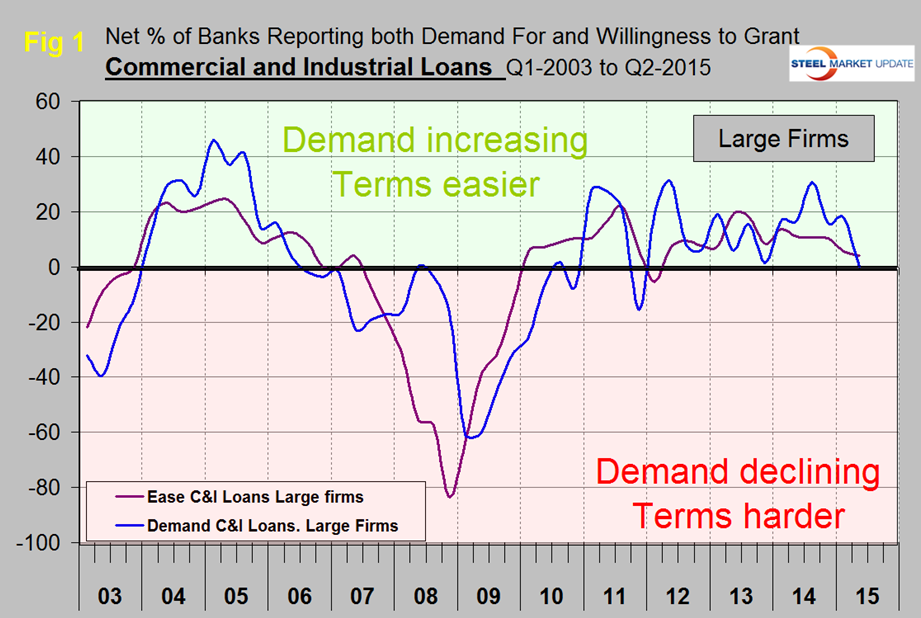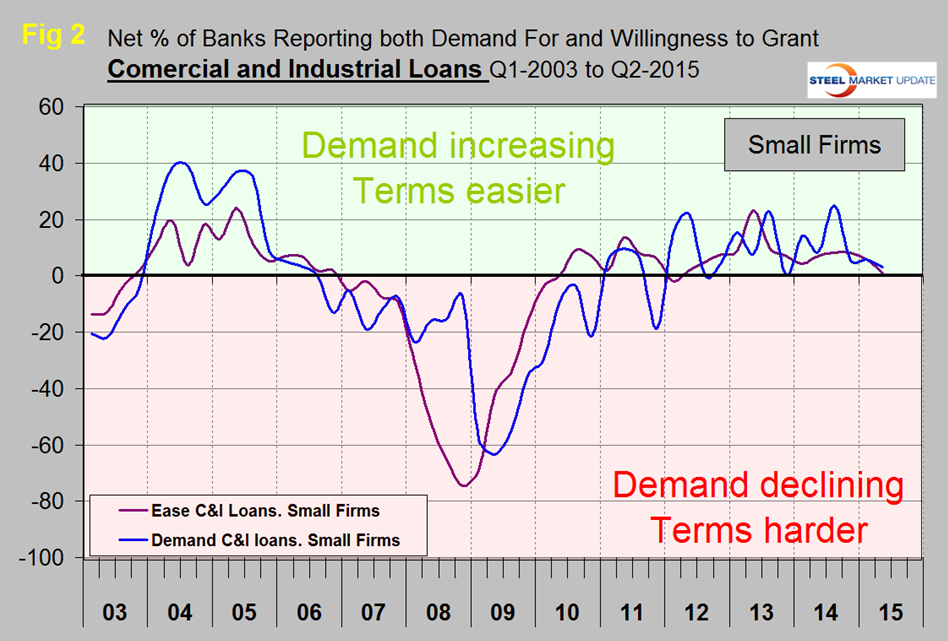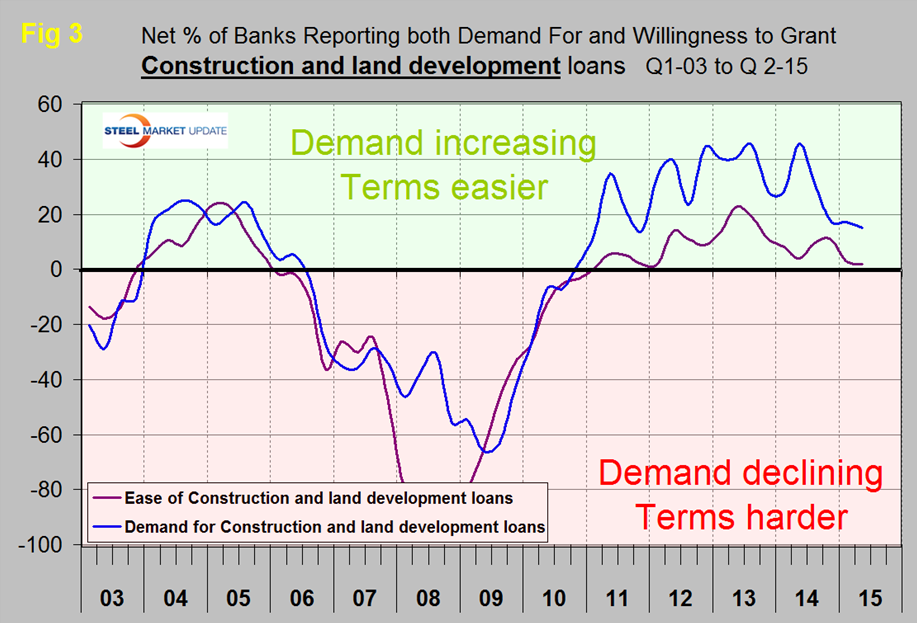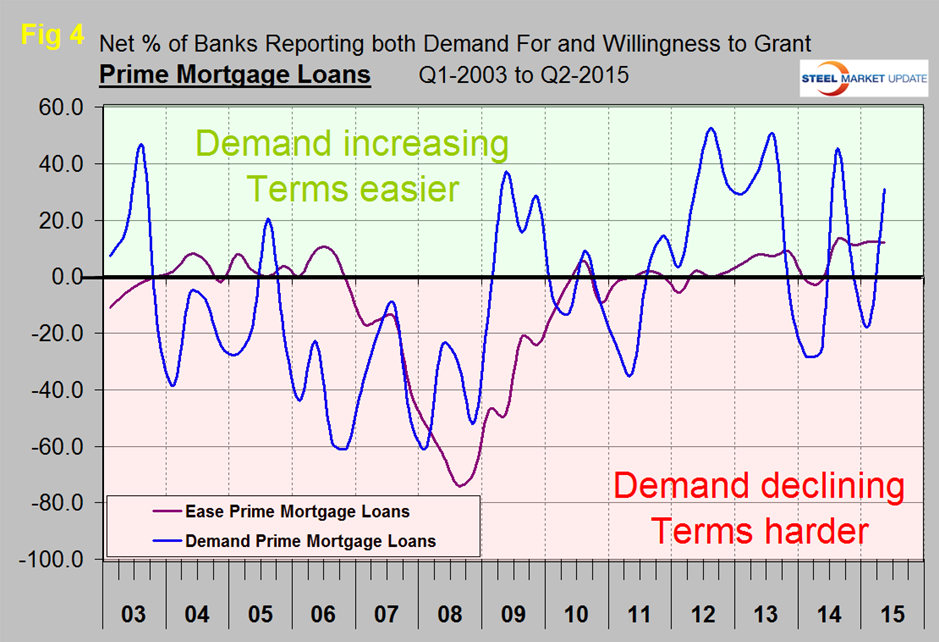Market Data

May 11, 2015
Federal Reserve Senior Loan Officer Opinion Survey on Bank Lending Practices
Written by Peter Wright
The Q2 2015 February Senior Loan Officer Opinion Survey on Bank Lending Practices was released on May 4th. This survey addresses changes in the standards and terms on, and demand for, bank loans to businesses and households on a quarterly basis and is based on the responses from 76 domestic banks and 23 U.S. branches and agencies of foreign banks. The Federal Reserve generally times the quarterly survey so that results are available for the January/February, April/May, August, and October/November meetings of the Federal Open Market Committee.
![]()
The following is an abridged version of the Federal Reserve report followed by SMU comments and graphs.
Lending to Businesses: The April survey results indicated that, on balance, banks reported little change in their standards on commercial and industrial (C&I) loans in the first quarter of 2015. On net, banks reported having eased some price terms. With respect to commercial real estate (CRE) lending, on balance, survey respondents reported having eased standards on loans secured by non-farm nonresidential properties. A few large banks also indicated that they had eased standards on construction and land development loans, and some large banks reported that they had eased standards on loans secured by multifamily properties. In addition, survey respondents reported having eased some CRE loan terms, on net, over the past year. On the demand side, banks indicated having experienced little change in demand for C&I loans in the first quarter; in contrast, respondents reported stronger demand for all three categories of CRE loans covered in the survey. The survey contained a set of special questions about lending to firms in the oil and natural gas drilling or extraction sector. Banks expected delinquency and charge-off rates on such loans to deteriorate over 2015, but they indicated that their exposures were small, and that they were undertaking a number of actions to mitigate the risk of loan losses.
Lending to Households: Modest net fractions of banks indicated that they had eased standards on loans eligible for purchase by government-sponsored enterprises (known as GSE eligible mortgage loans) and on government and qualified mortgage (QM) jumbo mortgage loans. Regarding changes in demand, modest to moderate net fractions of banks reported stronger demand across most categories of home-purchase loans. Modest net fractions of banks reported having eased their standards on, and experienced stronger demand for, home equity lines of credit. A small net fraction of large banks indicated that they were more willing to make consumer installment loans over the past three months. A few large banks reported having eased their standards for auto loans and for consumer loans other than credit card and auto loans, while standards for approving applications for credit card loans were about unchanged on net. Moreover, most terms on credit cards were reported to have changed little. Very few banks reported changes on any of the terms on auto loans or other consumer loans, except for a small net fraction of banks that reported having reduced the spreads of loan rates over the cost of funds for both loan types. A modest net fraction of large banks reported having experienced an increase in demand for credit cards over the past three months; a modest net fraction of smaller banks indicated having seen stronger demand for auto loans. In contrast, demand for other consumer loans was reported to have remained about unchanged.
There is a huge amount of valuable data in this report which can be accessed using this internet address by those readers who wish to dig deeper.
At SMU we extract and graph the major elements in the survey. Regarding loans to businesses, the April survey indicated that demand for commercial and industrial (C&I) loans from both large (> $50MM revenue) and small firms (< $50MM revenue) was almost unchanged (Figure 1 and Figure 2).
There was a minor tightening of lending standards to small firms to which a net 1.0 percent of banks reported an easing of standards, down from 5.7 percent in Q1 2015. What this means for example is that the number of banks reporting an easing of standards to small firms was 1.0 percent higher than the proportion reporting a tightening of standards. In reality most banks are not changing their standards. There was almost no change in the number of banks reporting a change in demand for construction and land development loans, demand is at the bottom of the range that has existed since mid-2011. The net percentage of banks reporting an easing of standards for construction loans decreased from 2.9 percent to 2.0 percent (Figure 3).
Demand for prime real-estate mortgages has been extremely erratic and seasonal for two years. In Q1 2015 a net 17.1 percent of banks reported a decline in demand as a net 31 percent reported an increase in Q2 2015. This level of variability is not mentioned or explained in the official write up by the Fed (Figure 4).
The implications of this report are reasonably good for steel people. Banks are not changing their lending practices for C&I loans or for CRE loans. Demand for C&I loans is stable and is increasing for CRE business. A net 9 percent of banks indicated an increase in demand for auto loans and a net 9.6 percent reported an increase in demand for credit card loans.











